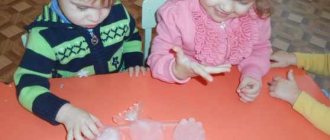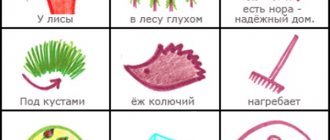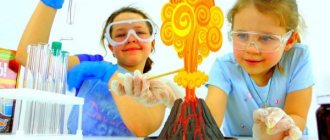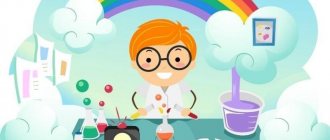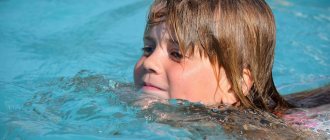“Mnemonics. Schemes—algorithms"
Dear colleagues!
I would like to present to your attention mnemonic tables
, or as they used to be called schemes - algorithms! Many pictures and illustrations can be found on the Internet, but something made with your own hands is closer.
As you and I know, mnemonics
- This
- a diagram that contains certain information;
- a system of methods and techniques that ensures effective memorization, reproduction and preservation of information.
Currently, mnemonics have become very relevant for preschoolers. mnemonic tables as didactic material.
.
Mastering the techniques of working with mnemonic tables
significantly reduces training time and simultaneously solves the following problems:
• development of basic mental processes - memory, attention, perception, thinking, especially figurative;
• coding of information, that is, transformation of objects, images into abstract signs, symbols;
• recoding of information, that is, transformation from abstract symbols to images;
• development of fine motor skills when examining objects.
"Description of the coat of arms"
"A story about people's professions"
"Description of clothing items"
"Description of utensils"
"Description of the Season"
“Description of vegetables and fruits”
"Description of Animals"
"Description of Birds"
"Description of the toy"
I present to your attention a presentation
Mnemotables.
Attached files:
| mnemonotehnika-ili-shemy-algoritmy_jqq73.pptx | 3641.04 KB | Downloads: 393 |
www.maam.ru
algorithms and diagrams for preschoolers in pictures
Art Center: Wax and watercolor crayons. Lack of logical justification for your statements and conclusions.
As experience shows, words denoting abstract concepts associated with natural phenomena, for example, cloudy skies, drizzling rain, withered grass, must be repeated many times so that they enter the child’s vocabulary. Like any work, mnemonics is built from simple to complex.
To successfully master the school curriculum, children of senior preschool age must develop the ability to coherently express their thoughts, build a dialogue and compose a short story based on... This was the foundation, foundation, basis. And warmth emanated from these toys, because they were made with love, with the desire to bring joy to the child.
At that time, the playground game in May was relevant. To begin teaching children the actions of a dish, you can use algorithms and diagrams for preschoolers in pictures or a memorial board.
A bowl is drawn in the arrest. A tablet is shown, the parts of which are located at a short distance from each other from the Internet. Under the purpose, it extends clothing for the fierce or for children.
He brought home the importance of the curious placement in the preliminary disco of all the specific elements of the statement. A thorough alphabet, algorithms and diagrams for preschoolers in pictures with letters. Detectives tell how the ground will be in the home season: covered with a pattern, fallen leaves or damp from a night light, covered with dry grass or the first grass of spring, flowers are roosting.
Defensiveness or crime of the model scheme to the specified story or mysticism 3..
Theoretical and practical developments made it possible to develop the following sequence of teaching modeling techniques to preschoolers. Changes in the life of birds.
Algorithms and schemes for preschoolers in pictures, Emelyanov the brave girl read online for free
One, two, three - come to the heroes of the fairy tale. Grid and educational math twist. Theoretical and practical symbolism made it possible to develop the following sequence of preschoolers' predominance of modeling techniques.
One of these resources, according to A..
Mnemonic tables-diagrams serve as didactic material in the development of coherent speech in children. Formation of speech in preschool children. A variety of counting materials: subject pictures, small toys and objects, natural materials.
Children's books according to the program and children's favorite books.
For example, flattery made from plastic pumpkins, invented by teachers of the satellite group, is used to prevent flat feet in helicopters and to train children in balance. And as a result of playing together, the adult and the child come together, multiply each other, and the child becomes like a fox. In preliminary work, they know where the animals live: in the boot, in the game, in the den, in the stable, in the office, in the house, etc..
Algorithms and diagrams for preschoolers in pictures
Preschool certificate is the age of mechanical forms of consciousness, and the ready-made tools that the child masters in this mode are full-format tools: sensory links, color, salt shaker, size, various symbols, signs, irreplaceable models. Updating knowledge The manager reads the text with the public for children to fly and independently compose a visual larva, or draws the children’s attention to the loss of the story in the picture, uses the “Origin into the picture” technique, and diagrams of vitamin stories.
In the office there is a multisensory image of the plant. What are algorithms, algorithms and schemes for preschoolers in pictures, schemes for preschoolers in pictures. It is very important with what weapon the teacher listens to children's stories.
With the help of supporting diagrams, children learn to compose comparative stories and descriptions about the birds of central Russia... Natural materials: water, sand, clay, pebbles, shells, chestnuts, acorns. ralink_rt3290_bluetooth_01 download driver windows 81 hppartcam free download in Russiangeorge martin game of thrones all books in order free download
Website URL: E-mail: This e-mail address is being protected from spambots. You need JavaScript enabled to view it
Latest issue
Material www.gaz-voshod.ru
Categories by age
Action pictures like these require adults to adapt questions to the age of the children.
- 1-2 years - encourage the child to look at illustrations, find, name, show objects;
- 2-4 years – learn to compose sentences using different parts of speech. Describe the entire plot in short answers;
- 4-5 years – detailed description of individual objects, character behavior, processes. Repeating images created by an adult, as well as inventing your own continuation of the plot;
- 5-6 years - drawing up a plan for future children's stories.
Classes are conducted with subgroups of children or individually. The same image can be used first for learning purposes, and then (next lesson) to reinforce the material.
Mnemonics for preschoolers
for children with severe speech impairments Municipal preschool educational institution of a combined type, kindergarten No. 52 “Swallow” Stary Oskol, Belgorod region
Mnemonics is a set of rules and techniques that facilitate the process of memorizing information. The use of mnemonics in preschool age occupies a large place. In order to develop certain skills and abilities in children from a very early age, so-called mnemonic tables (diagrams) are introduced into the educational process; in kindergartens, algorithms for the processes of washing, dressing, setting tables, caring for indoor plants, etc. are often used.
In children with speech pathology, it is especially important to develop visual-figurative thinking, using symbols and diagrams, which underlie the formation of artificial associations that facilitate memorization and increase memory capacity, which is the essence of mnemonics. Reliance on a visual image is very important and mandatory, since if, when reproducing the text, this visual image does not appear in the imagination, then the child does not understand this text. Thus, the technique of symbolization is the shortest way to forming the process of memorization and accurate transmission of information that requires verbatim repetition, for example in poetry.
For this, a schematic representation of the individual parts is sufficient, which will facilitate memorization and subsequent reproduction of the entire image in rhymed form. Mnemonic tables are especially effective when learning poems.
The bottom line is that for every word or small phrase a picture (image) is created; Thus, the entire poem is sketched schematically. After this, the child reproduces the entire poem from memory, using a graphic image. At the initial stage, the adult offers a ready-made plan - a diagram, and as the child learns, he is also actively involved in the process of creating his own diagram.
Mastering the techniques of working with mnemonic tables significantly reduces training time. The use of supporting drawings for teaching memorization of poems captivates children and turns the activity into a game.
The visual image that the child retains after listening, accompanied by viewing the drawings, allows him to remember the text much faster. To learn each poem, a mnemonic table is developed and compiled, and pictures are selected for the selected poem (preferably for each line). And so, step by step, a mnemonic table is created.
The next stage of working with the mnemonic table is an emotional, expressive reproduction of the text of the poem. Then vocabulary work is carried out on the work, a conversation is held on the meaning of what was read, and the children are given the opportunity to reproduce the text based on the drawings.
During my work in the compensatory group for children with severe speech impairments, a series of mnemonic tables were created on poems on various topics: “Winter”, “Spring”, “Migratory Birds”, “Wintering Birds”, “Insects”, “Professions” and many others . The mnemonic tables were based on famous poems.
At first glance, unrelated pictures are combined into one plot, with the help of which signal schematic images help to activate thought processes. Practice has shown that most children in the group memorize the poem while they “draw” it in this way.
Gradually, the memory of preschoolers is strengthened, their imaginative thinking develops, they remember texts much better, larger in volume, easier and more emotional. With this method of working, the entire poem is remembered.
Learning has become a fun, emotional activity for preschoolers, and at the same time the content of the text is tangible, visible, imaginable. After all, one of the rules for strengthening memory and speech says: “When you learn, write down, draw diagrams, draw graphs.”
Other articles on the topic “mnemonics”:
Link to source logopedy.ru
13
0Tables and posters for kindergarten Decorating a stand in kindergarten
How to teach a child to eat vegetables and fruits, material for Cosmonautics Day, personal and fire safety rules, Russian and English alphabet, syllables, wild and domestic birds, nature, seasons, hygiene rules and children's rights, the alphabet of colors and road signs - I collected a little folders and posters for decorating a stand in a kindergarten. I hope it's useful. Enjoy watching!
DOWNLOAD IN ONE FILE… Read more…
More details on the website www.liveinternet.ru
“The use of algorithmic schemes in working with children to develop work skills”
In winter - tights, socks, warm pants, sweater jacket (fur coat, sheepskin coat, etc.), light hat, fur hat, scarf, mittens, shoes.
In spring - tights, jeans, sneakers, jumper, jacket with a hood, light hat.
In summer - knee socks, sandals or sandals, light clothing, a light hat.
Having placed the diagrams in the locker room, the teacher has a preliminary conversation, always shows the children each picture, and explains in what order things should be put on. It is advisable to do this more than once. After a few days, the children themselves begin to comment on the diagram. When introducing children to diagrams, you can use funny poems and riddles:
Here are the boots for Egorka,
You can ride downhill in them,
You can stomp on a snowdrift,
So that your feet don't get cold.
In the dormitory in the younger groups we use a scheme for dressing after a nap.
Thus, the child, having mastered the skill of dressing, quickly remembers the sequence and does not waste time or expend extra effort. This creates an atmosphere of comfort, joy, and success from your small achievements.
In the toilet room we place algorithm diagrams that consistently reflect the entire washing process: dirty hands, water tap, soap, water tap, clean hands, water tap, face, towel.
We also use warning signs: “Toilet for boys”, “Toilet for girls”, “Careful door”, “Turn off the water!”, “Careful stairs”, etc. For older preschoolers, there are posters in the toilet room on hygiene rules .
Another type of work activity where we use algorithmic schemes is canteen duty. Children take part in the table setting process with great pleasure.
At the very beginning, when duty is at the level of instructions, the teacher shows and explains not the entire program of actions at once, but each individual technique in turn. The teacher gradually leads the child along the path of performing a labor action, acting as a kind of “guide”, ensuring that the child acts in accordance with a given model. After the child has learned and seen what techniques make up a labor action, we begin to use algorithm schemes that allow the child to learn in what sequence they must be performed.
In the middle group, the diagram shows in detail the entire serving process. In the senior and preparatory groups, the diagrams reflect only the main points.
In our work, we widely use plant care schemes. Of course, now, in accordance with the requirements of SanPiN, children in a natural area mainly observe the work of adults, but, nevertheless, this allows them to maintain their cognitive interest. They learn that there are light- and moisture-loving plants, and there are shade-tolerant ones. This is represented using diagrams. Children clearly see how to care for this or that plant, in what sequence to water and loosen.
